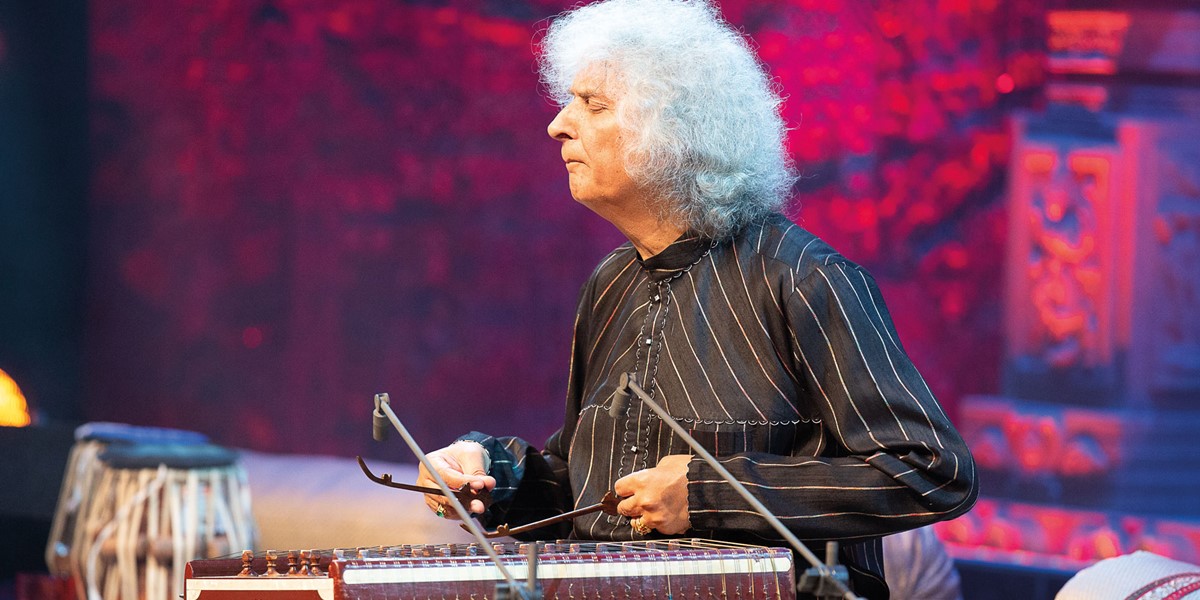Wednesday, November 6, 2019
Shivkumar Sharma: A Beginner's Guide
Oliver Craske profiles the man who adapted a folk instrument – the santoor – into a vehicle for Indian classical music

Shivkumar Sharma (photo: Arnhel de Serra)
Shivkumar Sharma has called his life a ‘journey with a hundred strings’. He is one of those rare musicians who is synonymous with an instrument – in his case, the santoor. That its shimmering, celestial beauty adorns Indian classical music today is thanks entirely to his efforts and talents. Not only is he its best known exponent, he completely revolutionised its design and fought an ultimately triumphant battle for its recognition.
Sharma is a member of the Dogra community from Jammu, in India’s north. He grew up in a musical household. His father, Uma Dutt Sharma, was a singer and music director at Radio Jammu, and often had music disciples staying. Shivkumar was an introverted, religious boy who had a natural passion for Indian classical music, and also loved film music and the local Dogri folk styles too. Aged five, he began learning vocal music and tabla from his father, and explored many other instruments, before, at 14, his father returned from a posting in Srinagar with a present – a santoor.
The Kashmiri santoor is a hammered dulcimer, trapezoidal in shape, played with a pair of light mallets. It is smaller than the Persian santur and a distant relative of the European cimbalom and dulcimer. At the time it was used by Sufi communities in the Kashmir valley to accompany vocal music. His father set him an extraordinary challenge: to take the santoor to new heights, and make it accepted as a vehicle for classical music.
By 1955, aged 17, he was playing tabla and santoor on Radio Jammu, but initially it was his tabla skills dominated. The santoor was looked down upon as a folk instrument. That year, Sharma performed at a music festival in Bombay and was the first to play santoor on an Indian film soundtrack, for V Shantaram’s Jhanak Jhanak Payal Baje. But years of struggle followed. A turning point came when he was invited to play on All India Radio’s prestigious National Programme of Music, and then had the invitation withdrawn because the advisory board declared that the santoor was incapable of rendering a raga. Sharma acknowledged that the criticism had some validity because he was unable to play meend phrases, the curving slides between notes that are an essential feature of the slow, opening alap passages. So he set out to redesign the instrument.
Most radical were his changes to the tuning system. On the Kashmiri instrument no more than seven notes could be played per octave, ruling out certain ragas. His new design completely revamped the strings, so that there were 91 strings in all, rather than 100, but it was now possible to play every semitone. He also improved the tone, changing the brass strings to steel, and removing the wooden stand upon which Kashmiris traditionally rested the instrument, which created unwelcome resonances in faster passages. He began to play it sitting cross-legged with the instrument resting wholly on his lap. Remarkably, he developed a technique with the mallets that allowed him to play meend phrases. The new santoor was a revelation, capable of playing all classical ragas.
In 1960 Sharma decided to seek his musical fortune in Bombay. Arriving almost penniless, he picked up radio and film work and recitals, and began a recording career on HMV India. Gradually, money worries receded as he became a busy session musician on film soundtracks. “I must have played in hundreds of movies,” he said recently. He was even offered the lead role in a film by the director KA Abbas, but he declined, for his focus was on fulfilling his father’s dream. Like many Bombay musicians, he built parallel careers, working in film while also developing his classical reputation.
Sharma’s big commercial breakthrough was the 1967 album Call of the Valley, which he recorded with two great friends, flautist Hariprasad Chaurasia and guitarist Brijbushan Kabra. This concept album, themed around a day in the life of a Kashmiri shepherd and styled as ‘a symphony in Indian classical music,’ was an international hit, chiming with the era’s global fascination for India. It was Sharma who had the original idea, inspired by Jammu’s scenery and its hill peoples. “My music is inspired by nature,” he explained.
His first foreign tour was as part of Ravi Shankar’s Festival from India line-up that toured the US and Europe in 1968, when he was still playing both tabla and santoor. (He put tabla aside the following year.) Shankar took him abroad again in 1973 and 1974, culminating in George Harrison’s Dark Horse tour of American arenas. From then on Sharma was in demand on the international circuit, although he mostly preferred to play solo shows, concerned primarily with gaining appreciation for santoor in its own right and not as an accompanying or duetting instrument.
In 1981 he formed a hugely successful partnership with Hariprasad Chaurasia as Bollywood music directors, known as Shiv-Hari. Eight films followed over the next dozen years, seven of them for superstar director Yash Chopra. The song ‘Rang Barse’ from Silsila (1981) has become a ubiquitous Holi festival anthem, while the love songs in the Sridevi vehicle Chandni (1989) helped trigger a shift towards the romances that dominated Bollywood in the 1990s.
Shiv-Hari have always enjoyed a harmonious friendship, but it was not until 1995 that they first performed together on stage. They created a follow-up to Call of the Valley in the form of a concert in Mumbai on the theme of peace, love and harmony, released by Navras as The Valley Recalls. This happily led on to further live duets, for the timbres of santoor and flute combine to blissful effect.
Today, it is clear that Shivkumar Sharma must have far exceeded his father’s wildest dreams for the santoor. New generations have taken it up, among the best of whom is Rahul Sharma, Shivkumar’s own son and disciple. Shivkumar Sharma himself is now one of Indian’s music’s elder statesmen, but he is still driven to seek out that moment of transcendence when the music, musician and audience become one.
This article originally appeared in the November 2019 issue of Songlines. Never miss an issue – subscribe today!

